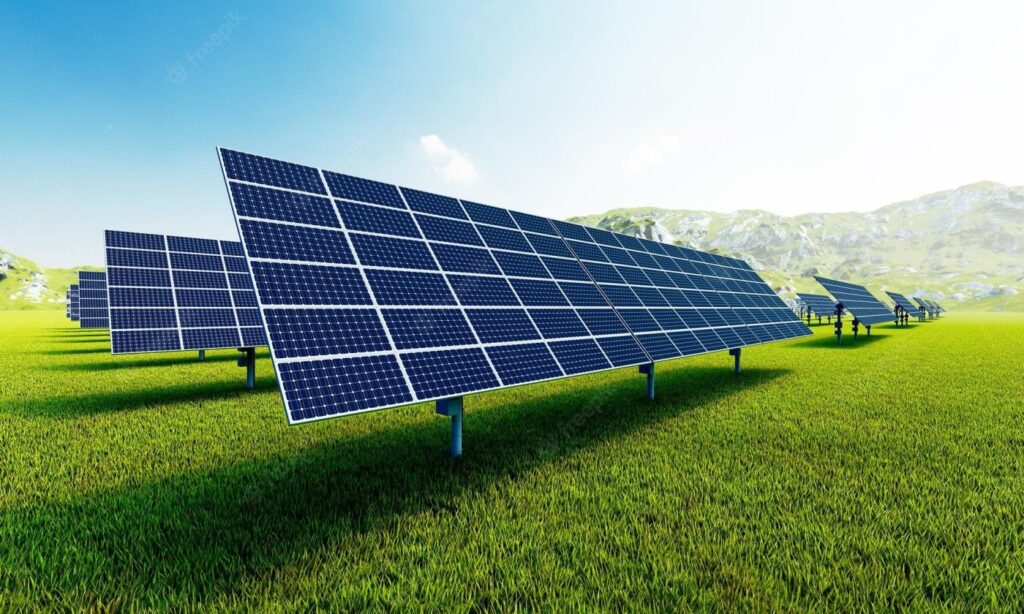In today’s world, renewable energy is no longer just an option; it’s a necessity. Among the various green technologies, Photovoltaic (PV) Solar Plants have emerged as one of the leading solutions for clean, sustainable energy. They are already transforming how we power our homes, industries, and cities — and their influence is only growing.
Let’s dive into how PV solar plants work, their current status, future prospects, their role in reducing carbon emissions, and a glimpse at some of the largest PV plants around the world.
How a PV Solar Plant Works
At the heart of every PV solar plant is the photovoltaic effect, a process where sunlight is directly converted into electricity.
When sunlight (made up of tiny packets called photons) hits a solar panel, it excites the electrons inside the silicon cells of the panel. This movement of electrons generates direct current (DC) electricity. Since our homes and industries use alternating current (AC), an inverter is used to convert DC to AC.
In a PV solar plant:
- Thousands or even millions of panels are installed over large areas, usually arranged in rows.
- Solar trackers are sometimes used to follow the sun’s path, maximizing power generation.
- Inverters, transformers, and control systems manage the produced electricity.
- The power is then fed into the national grid or used directly by nearby industries or communities.
Simple, clean, and efficient.
The Present: Where We Stand Today
As of 2025, the world has over 1,300 gigawatts (GW) of installed solar capacity. The top countries leading the charge are:
- China (by far the largest producer)
- United States
- India
- Germany
- Japan
Solar technology costs have dropped by around 85% over the past decade, making solar energy cheaper than fossil fuels in many parts of the world.
Today, solar is not just about small rooftop panels; massive solar farms now stretch across deserts, agricultural lands, and even floating on lakes.
List of Some of the World’s Largest PV Solar Plants (by MW)
Here’s a list of some of the largest and most impressive PV solar plants as of 2025:
- Bhadla Solar Park (India) — 2,245 MW
- Tengger Desert Solar Park (China) — 1,547 MW
- Noor Abu Dhabi (UAE) — 1,177 MW
- Pavagada Solar Park (India) — 2,050 MW
- Benban Solar Park (Egypt) — 1,650 MW
- Golmud Solar Park (China) — 2,800 MW (planned expansion)
These mega-projects show how the world is rapidly shifting to large-scale, sustainable energy production.
How PV Solar Plants Reduce Carbon Emissions
Fossil fuels like coal and oil release enormous amounts of carbon dioxide (CO₂) when burned, one of the primary causes of global warming.
Solar plants generate electricity without burning anything.
This means zero direct carbon emissions during operation.
By replacing coal and gas-fired power plants, solar farms help avoid millions of tons of carbon emissions every year.
On average:
- Each megawatt-hour (MWh) of solar energy avoids about 0.5 to 0.7 metric tons of CO₂ compared to coal.
- A 100 MW solar plant can prevent approximately 70,000 metric tons of CO₂ emissions every year.
How Much Carbon Solar Has Reduced in the Last 20 Years
Between 2005 and 2025, thanks to the rapid growth of solar energy:
- Around 5 to 6 billion metric tons of CO₂ emissions have been prevented globally by PV solar plants.
To imagine this impact:
- That’s roughly equivalent to taking more than 1 billion cars off the road for a year.
- Or planting around 100 billion trees!
It’s one of the clearest proofs that shifting to renewables is essential for the planet’s future.
The Future of PV Solar Plants
The future looks even brighter for PV solar:
- Massive Growth Ahead:
By 2030, the world is expected to have over 4,500 GW of installed solar capacity, according to the International Energy Agency (IEA). - Cheaper and Better:
New technologies like perovskite solar cells and bifacial panels (which capture sunlight from both sides) will make solar even more efficient and affordable. - Solar + Storage:
Pairing solar plants with battery storage systems will allow us to store power for use at night, solving the biggest challenge for solar energy. - Floating Solar:
Solar plants built on lakes, reservoirs, and even oceans (“floatovoltaics”) are a rising trend, especially in land-scarce countries. - Decentralized Energy:
With microgrids and smart grids, solar plants will empower communities to produce and manage their own energy, reducing dependence on large, centralized power plants. - Global Impact on Carbon:
If current trends continue, solar energy could help avoid up to 30 billion metric tons of CO₂ emissions by 2050, playing a huge role in keeping global warming under 1.5°C.
Conclusion
PV solar plants are not just a technological marvel — they are a symbol of hope. In just two decades, they have saved billions of tons of carbon emissions, created millions of green jobs, and made clean energy affordable.
As costs keep falling and technologies improve, solar power will be at the heart of a global energy revolution. A future where the world is powered by the sun — clean, abundant, and infinite — is no longer a dream. It’s happening right now.
And the best part?
The sun rises every day, free for everyone.

